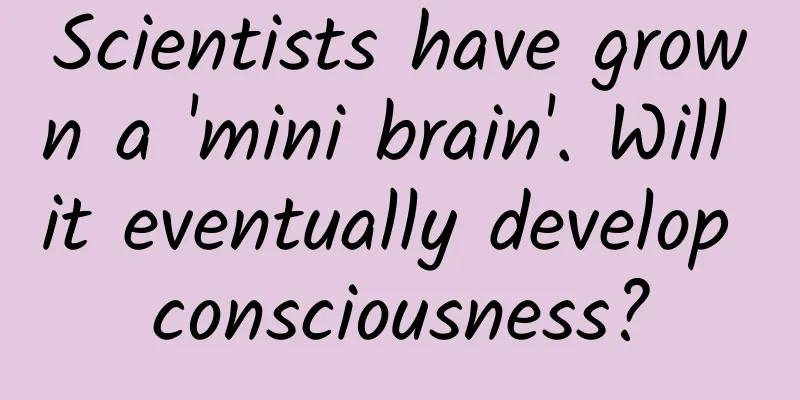Scientists have grown a 'mini brain'. Will it eventually develop consciousness?

|
Scientists are growing "mini brains" (also known as brain organoids) in culture dishes, hoping to simulate some brain functions through these clusters of brain nerve cells and deepen and change our understanding of brain neural development and diseases. They strive to make them more like the human brain, and progress has been particularly rapid in recent years. They have discovered some surprising phenomena, such as neurons grown in vitro will spontaneously excite, which is one of the ways neurons grow and establish new connections in the human brain; active brain waves similar to those seen in the brains of premature babies have been observed in brain organoids, and this whole-brain coordinated electrical activity is one of the characteristics of conscious brains. So the question becomes urgent: Will these brain organoids eventually develop consciousness? Scientists are looking for the answer. Written by | Xiaoye In the 1980s, American philosopher Hilary Putnam proposed the famous "brain in a vat" thought experiment. Less than half a century later, biologists have been able to cultivate a real version of the "mini brain in a vat" in a laboratory dish - brain organoids. Although this is a cluster of brain nerve cells that is only a few millimeters wide, it can already simulate some brain functions. And we soon face an important question: Can such brain organoids generate consciousness? Brain organoid research is advancing rapidly Organoids, also known as mini-organs, are, as the name suggests, miniature models similar to real organs. They are formed by self-organization through in vitro three-dimensional culture of pluripotent stem cells or adult cells. They are highly similar to the structure of human organs and can reproduce some of the functions of the imitated organs. The origin of organoids can be traced back to 1907, when H.V. Wilson, a professor of zoology at the University of North Carolina, published a paper[1] that revealed that mechanically separated sponge cells could reaggregate and self-organize into a new sponge with the same normal life functions. By the 1950s, other scientists had carried out similar experiments using cells from other animals, demonstrating that vertebrate cells all possess the ability to self-organize. This laid the foundation for an important feature of organoid culture technology that would become indispensable in the future: self-organization. It is like winding up cells. As long as a suitable culture environment is provided, the cells will perform their respective functions and self-organize to form organoids [2]. Stem cell technology is another key to the booming development of organoids. In the 1980s, the team of former Soviet scientist AJ Friedenstein conducted a series of cutting-edge experiments and discovered an osteoblast stem cell[3] or bone marrow stromal stem cell[4] in the bone marrow, which can generate a variety of bone tissues through in vivo experiments[5]. In the 1990s, Arnold Caplan, a professor of biology at Case Western Reserve University in the United States, renamed it mesenchymal stem cell (MSC)[6], and eventually this name was generally accepted by the academic community. MSC has been proven[7] to be a multipotent stem cell with the ability to self-renew and multidirectionally differentiate, which can be transformed into various cell types and has a wide range of clinical application value. Also in the 1980s, Professor James Thomson, a developmental biologist at the University of Wisconsin-Madison, also devoted himself to this field for a long time, exploring the potential of stem cells in primates. It was not until 1998 that he used donated human embryos to construct the world's first human embryonic stem cell line[8]. In 2007, he collaborated with Shinya Yamanaka's team at Kyoto University in Japan to successfully induce human adult cells into pluripotent stem cells (iPSCs)[9]. iPSC cells have the potential for unlimited proliferation in vitro. They can not only express stem cell markers in embryonic stem cells, but also have the potential to differentiate into cells or tissues of the three germ layers[10]. At this point, everything is ready. The rapid development of self-organizing properties and stem cell fields has injected new vitality into organoid research. The first decade of the 21st century has seen a flourishing display of results: liver organoids[11], intestinal organoids[12], retina, prostate, lung, kidney, breast, brain organoids, etc. have been successfully cultivated. Organoids have become a hot research topic with their rapid development. In 2013, organoids were named one of the top ten technologies of the year by the journal Science[13]. Another 10 years later, in its prediction of the "Top Ten Breakthrough Technologies in the World" in 2023, MIT Technology Review predicted that as researchers explore how to design complex tissues from scratch and cultivate customized organs in factories, engineered organ manufacturing technology will mature in the next 10-15 years. Among the many organoids, brain organoids are particularly important. For hundreds of years, unraveling the mysteries of human brain development and neurological diseases has been a major challenge in the field of brain science and medicine. The academic community has made various efforts, not only to establish various in vivo and in vitro cell and animal models, but also to try to use two-dimensional methods to culture human brain neurons to analyze the mechanisms of related diseases. However, for animal models, due to species differences, laboratory animal brain models cannot fully simulate the complexity of the human brain, and the experimental results may not be fully applicable to the human brain. The spatial structure, cell type complexity, interaction, and microenvironment of two-dimensional neurons grown in culture dishes are also far from those of the three-dimensional human brain [14]. Brain organoids just make up for the above shortcomings. In 2008, the team of Japanese stem cell biologist Yoshiki Sasai discovered[15] that cortical-like structures can be generated in neurospheres derived from spontaneous stem cell organization, including cortical progenitor cells and functional neurons. This is the first primary brain organoid model. In 2013, Jürgen Knoblich of the Institute of Molecular Biotechnology of the Austrian Academy of Sciences and Madeline Lancaster, a developmental biologist at the University of Cambridge in the United Kingdom, published a paper in Nature[16], reporting the first three-dimensional brain organoid derived from human pluripotent stem cells. The team used biological gel matrigel to simulate the surrounding tissue of the brain, and used a rotating bioreactor to help the absorption of nutrients and the diffusion of oxygen. In this continuous three-dimensional suspension culture, growth factors that promote neural development were added, and finally a further improved brain organoid culture was obtained, which contains multiple independent and interdependent brain region structures such as the forebrain, choroid plexus, hippocampus, and prefrontal lobe. Subsequently, scientists around the world continued to explore various brain organoids with brain region specificity. They combined different small molecules and growth factors and successfully obtained brain organoids including the midbrain, thalamus, cerebellum, striatum, etc. Other scientists have tried to assemble two or even more brain region organoids to form "assembloids" to further simulate the human brain development, neuronal migration and other processes under real conditions. For example, a paper published in the journal Cell Stem Cell in 2019 [17] fused thalamic organoids with cortical organoids to simulate the bidirectional projection process of neurons between the thalamus and the cortex. In addition to assembling multiple brain regions, there are also studies [18] that assemble brain organoids with non-neural organoids such as muscle tissue to observe the dominant role of nerves on other tissues, and obtained results similar to those in the real human body. A simplified diagram of the development of brain organoid technology, source: 10.1038/s41392-022-01024-9[19] Differences from the real brain In fact, brain organoids are only a few millimeters wide and are a cluster of cells similar to the brain. As a mini model cultivated in the laboratory, it has advantages that other brain research methods do not have. For example, when electrodes are connected to brain organoids, signal transmission between neurons can be triggered, spontaneously imitating the real brain. So, are brain organoids miniature versions of the real brain? In reality, this is not the case. The current brain organoids do not completely match the real brain. First, the most significant drawback of brain organoids is that they stop growing after they grow to a few millimeters because there are no blood vessels to provide oxygen and nutrients. Unlike natural biological tissues, the growth of brain organoids depends on the nutrient solution that permeates into the culture dish. Once they grow to a certain size, if there is not enough nutrition, the growth stops and the cells in the center begin to die. Unfortunately, they die long before they grow like a real brain. Therefore, various teams have tried every possible way to grow blood vessels in brain organoids, culture vascularized organoids and fuse them with brain organoids, or artificially open channels in brain organoids to allow more nutrient solution to be infused into them and produce more mature synapses[20]. Second, unlike real brains, brain organoids lack sensory input from their surroundings, which is essential for the development of brain circuits. Brain organoids have no eyes to see, no ears to hear, no nose to smell, and no mouth to taste. Isolated in a petri dish, brain organoids cannot autonomously encode experience and information without sensory input. [21] A paper published in the journal Nature in 2020 put forward a relatively restrained view [22], stating that the currently widely used brain organoid models are still unable to replicate the basic characteristics of real brain development and organization, let alone simulate the complex brain circuits required for complex brain diseases and normal cognition. Researchers found that one reason behind this is the "identity crisis" of organoid cells: brain organoid cells cannot normally differentiate into unique cell subtypes, and a "hodgepodge" of various genes can be found in cells of completely different types, causing the developmental program to fall into chaos. Another reason is that the laboratory culture method causes cells to be "stressed": all brain organoid models express abnormally high levels of cell stress response genes, which leads to abnormal cell behavior and the production of abnormal proteins, and ultimately causes organoid cells to fail to develop normally [23, 24]. The development of a real brain is like a symphony, with various instruments playing simultaneously and coordinating with each other under the coordination of a conductor to produce a beautiful and harmonious complex movement. Organoid scientists have just taken the first step to achieve such a level of complexity in brain organoids. Can brain organoids develop consciousness? Although brain organoids are still far from real brains, this does not prevent scientists from thinking ahead to a question: Will the "brain-like" in the petri dish eventually develop consciousness? Based on the current research situation, most brain organoid scientists believe that brain organoids will not and cannot develop forms of consciousness. Lancaster, the first person to grow brain organoids, believes that current brain organoids are still too primitive to produce consciousness, as they lack the anatomical structure necessary to create complex EEG patterns. Although brain organoids "may have neurons that communicate with each other in the absence of input and output, this does not necessarily imply anything resembling human thought and consciousness."[25] In the view of Lancaster and most researchers, "rejuvenating" dead pig brains is more likely to produce consciousness than brain organoids. In June this year, Kenneth Kosik, a neuroscientist at the University of California, Santa Barbara, published an opinion article in the journal Patterns[26], suggesting that brain organoid research may eventually create consciousness in the laboratory, but based on current technology or even future technological conditions, this possibility does not exist. First, as mentioned above, although the significant flaws of brain organoids indicate that they do not yet meet any operational definition of consciousness, scientists still have many obstacles to overcome to overcome these flaws. It is still too early to discuss whether organoids will generate consciousness. Secondly, for the question of "what is consciousness", philosophers and scientists have been constantly exploring for thousands of years, with a variety of theories, and there is still a lack of a generally accepted definition. Modern science classifies consciousness into the category of scientific problems. From the perspective of neural mechanisms, it can be divided into four categories of theories: higher-order theory (HOT), global neural workspace theory (GNWT), integrated information theory (IIT), and reentry and preprocessing theory. These theories not only explore the problem of consciousness around the brain, but also emphasize the importance of the interaction between the subject's body and the environment, affecting the various abilities required for the generation of consciousness: representation, senses, perception, etc. One of the most obvious characteristics of brain organoids is that they are completely separated from the body, whether in movement or perception, without any somatic experience history. Although experiments have shown that the neural discharge activity of brain organoids is similar to the pattern related to the brain encoding experience, there is still a question: Can a framework (brain organoid) that can encode experience but has no experience history produce consciousness? Without content, can consciousness exist? As early as 2022, Kosik published a long article in the journal Nautilus[27], proposing that an important reason why brain organoids have no consciousness is that they do not possess the core property - the ability to abstract. Consciousness requires an abstract process, which is based on the correlation between our impression of the sensory world and motor feedback. When we see a red apple on the table, the following process is triggered: the light reflected by the object activates the photoreceptors in the retina and transmits a signal to the brain; the signal contains rich information about the object's color, size, and environment. After years of life experience in the world, the discharge patterns corresponding to the two concepts of the words "red" and "apple" have been generated, and finally we "realize" that there is a red apple on the table. However, the neural discharge activity of brain organoids is not associated with anything in reality. Of course, there are also scientists who hold positive opinions. Anil Seth, a cognitive neuroscientist at the University of Sussex in the UK, said in a Nature podcast [28] that he does not rule out the possibility of brain organoids developing consciousness. As the complexity of brain organoids and their similarity to the human brain continue to increase, even if their structure is not completely identical to the human brain, it is entirely possible that they can have conscious experiences. Although most scientists hold a negative view, some interesting experiments suggest that the basic elements of consciousness may have gradually emerged. In the lab of neuroscientist Alysson Muotri at the University of California, San Diego, there are hundreds of petri dishes filled with sesame-sized brain organoids. He uses a variety of unusual methods to manipulate brain organoids, and one of the results of his experiments has attracted widespread attention. In 2019, Moutri's team published a paper in Cell Stem Cell[29] reporting the creation of brain organoids that can produce coordinated activity waves, similar to the activity waves seen in the brains of premature babies. This whole-brain coordinated electrical activity is one of the characteristics of conscious brains, so the team believes that brain organoids basically simulate the early development process of the human brain. However, there are also doubts about this result, mainly because brain waves similar to those of premature babies do not mean that brain organoids can be equated with infant brains. Moreover, infants' brain waves are different from those of adults and often show very chaotic and irregular fluctuations. A dish of brain organoids in Muotri's lab.Credit: David Poller/ZUMA Wire, via Alamy Live News In the same year, Hideya Sakaguchi's team at Kyoto University reported in the journal Stem Cell Reports [30] that they had successfully visualized the network activity and connections between individual neurons in cortical spheroids. The team detected dynamic changes in calcium ion activity and discovered integrated activity between cells that were able to organize themselves into clusters and form networks with other nearby clusters. The manifestation of synchronized neural activity can serve as the basis for a variety of related brain functions, including memory. Another key finding of the study was that neurons grown in vitro spontaneously fire, which is one of the ways neurons grow and establish new connections in the human brain. Unavoidable ethical issues The academic community has different opinions on the issue of consciousness, but scientists also recognize that it is much easier to create a conscious system than to define it. Therefore, brain organoid research also highlights a blind spot: scientists have no agreed-upon method to define and measure consciousness. Even Muotri himself admitted that he did not know which definition to use to determine whether an organoid has reached a conscious state. Therefore, whether brain organoids have consciousness has become a personal theoretical preference of researchers, which will affect their research methods and purposes. So, be prepared. Anil Set proposed that when there is no clear method to evaluate the consciousness state of organoids, an ethical framework must be determined preemptively. Karen Rommelfanger, director of the Neuroethics Program at Emory University in the United States, also agreed that the differences between brain organoids and other body organoids research involve not only biological aspects, but also ethical aspects. Andrea Lavazza of the University of Pavia in Italy believes that in the future, organoids may show the ability to experience basic sensations such as pain, thereby demonstrating perception and even basic forms of consciousness. This requires us to consider whether brain organoids should be given moral status and what restrictions should be introduced to regulate research [31]. Special Tips 1. Go to the "Featured Column" at the bottom of the menu of the "Fanpu" WeChat public account to read a series of popular science articles on different topics. 2. Fanpu provides a function to search articles by month. Follow the official account and reply with the four-digit year + month, such as "1903", to get the article index for March 2019, and so on. Copyright statement: Personal forwarding is welcome. Any form of media or organization is not allowed to reprint or excerpt without authorization. For reprint authorization, please contact the backstage of the "Fanpu" WeChat public account. |
<<: New breakthrough! The heaviest so far, scientists successfully observed for the first time →
>>: The Empress Dowager Cixi couldn't eat Ma Xiaoer? The past of crayfish "conquering" the world...
Recommend
10 correct working postures, I bet you can't do any of them!
I believe everyone has heard that sitting for a l...
WeChat red envelope cover upgrade: individuals can also customize
On November 4, the WeChat red envelope cover team...
After multiple attempts, where is the point for video websites to turn losses into profits?
From exclusive broadcasting to paid broadcasting,...
Red, yellow, orange... Why do green leaves turn into different colors when the weather gets cold? The most beautiful science is here
Expert of this article: Jiang Chenkun, School of ...
Vanguards descend from the sky: airborne troops to safeguard national security
Airborne troops are troops that use aircraft as t...
The future of smart remote controls: infrared or Wi-Fi?
Recently, according to media reports, Alibaba has...
The eighth course of the Xiaomao Qianqian Writing Training Camp
The course comes from the eighth session of Xiaom...
As of 2021, there are several popular 5G mobile phones. Which one are you using?
A few months ago, it seemed that 5G was still syn...
Tesla delivered 6,244 cars in the UK in Q3, exceeding the total for the whole of 2018
Recently, Tesla announced its third-quarter sales...
Douyin Store Practical Training Camp starts from 0, Douke Alliance expert sales model, super detailed Q&A
Douyin Store Practical Training Camp starts from ...
Win10 mobile supports x86 applications: Microsoft beats Apple and Android in the spring
The industry has always had different views on the...
"Meow meow" has different meanings. Here's how to interpret cats' little tricks in one second
What sounds does your cat often make? Can you tra...
Useful Tips | 230 essential jargon words for marketers!
We hate slang, but we can't completely get ri...
College entrance examination scores in many provinces announced! Quick check!
Since the 23rd, the college entrance examination ...
@Newton: I never thought that my dog could also discover anti-physical phenomena!
Written by: Zhu Hengheng Editor: Wang Haha Layout...









